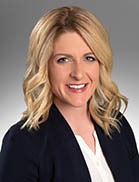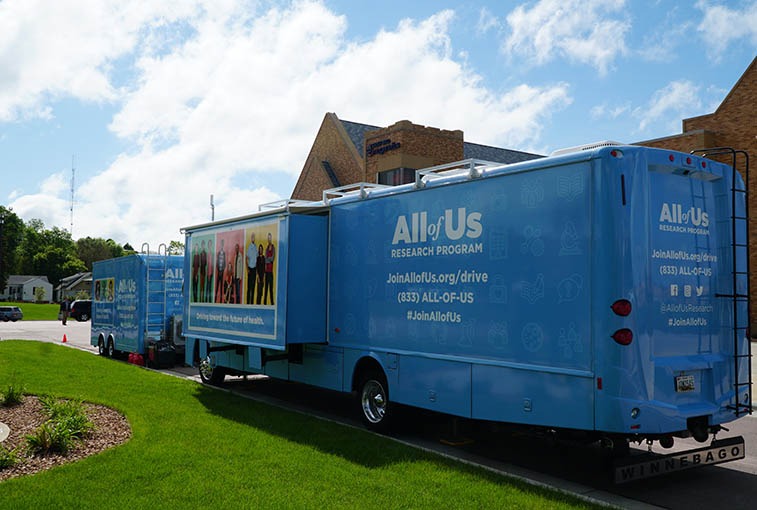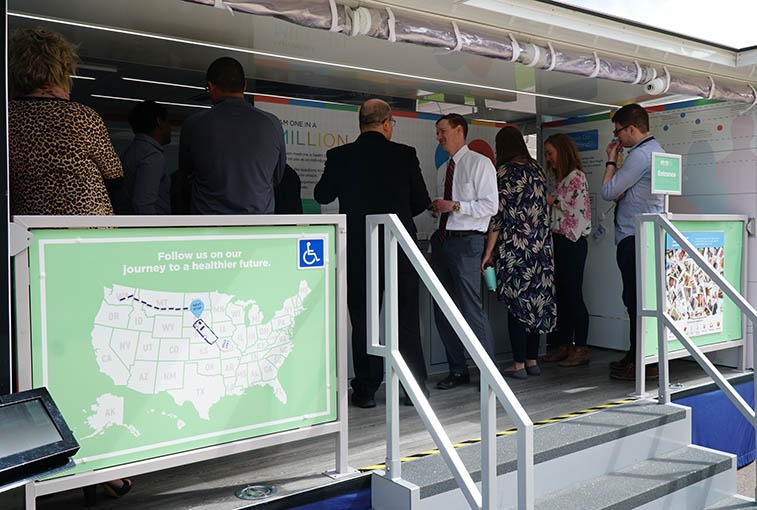Imagine a utopia where everyone suddenly got healthier. They exercised regularly and ate what they should. And they seldom needed to spend time and money to see a doctor for illnesses or to take multiple medications.
That sounds idyllic — but then what happens to hospitals and clinics? That’s where something revolutionary can happen. With fewer sick patients, health systems can begin moving from treating illness to supporting wellness. And the payments would follow: Money currently invested in interventions could be targeted toward prevention.
An increasing number of health systems, including Sanford Health, have started taking steps toward a climate that resembles this utopia. This movement has a fairly new name: population health.
What is population health?
Population health is difficult to grasp in a sentence or two. Even across health care systems, it can take on different meanings.
Sanford Health defines it as the transition to value: taking meaningful, strategic steps to help patients and the system move from taking care of people once they’re sick to helping them practice healthy lifestyles today. Then they can lower their risk of preventable conditions or incidents that could otherwise send them to the emergency room, or into surgery, or to their doctor for medications.
Patients save time, money and heartache this way. And hospitals and medical staffs can concentrate their resources more on patients with serious medical needs. The healthiest patients may need just a doctor visit a year and their recommended screenings. So it actually saves money all around — prevention typically costing far less than the cure.

“I like to think about population health as total health,” said Emily Griese, director of population health for Sanford Health. “So that includes, ‘We can absolutely fix patients when they’re broken,’ but we can also understand and support all of the upfront work that can help that fix from ever being needed.”
This is not an easy transition for any health care system, or we’d already see widespread adoption throughout the nation. It involves many factors. Technology, for example, plays a role in collecting data and analyzing it. The business side explores shifting payment models by health plans and the government.
And the human side tries to identify barriers faced by patients in everyday life, including making sustainable and meaningful changes to begin living a healthy lifestyle. It looks at how those differ for different populations: those living in rural communities; those with busy young families; or those who struggle to afford healthy foods.
Finding that one person in a crowd
The word “population” in the term population health sounds as though people are treated like numbers. It might seem as if they’re simply lumped into a group of “like” people. Low-risk patients who don’t have many, or any, health issues, for example. Or high-risk patients, who might have a serious condition or for other reasons visit the health care system frequently. Or rural patients who have more trouble accessing specialists or other health care resources.
In a sense, that perception rings true. Technology has made it easier to analyze data about the people in each of these types of populations. Everyone’s information — their age, sex, health history and risks, for starters — blends together. This helps form an overall picture of the group that can help health systems see trends and plan where to direct their resources.
But in another sense, population health can allow health care teams to get personal. To pinpoint individuals using the health care system who might need a helping hand of a different sort — and then help guide them to that helping hand.
In other words, even when looking at a whole crowd of people, population health still sees that lone person struggling. It investigates why he or she struggles. It explores measures that can remove his or her barrier to better health.
Population health reads the stories of the people behind the numbers — and then tries to improve their storylines.
Piecing together a patient’s puzzle
“I think as we get increasingly better at recognizing all of the complexities around individuals’ health, that it’s not just their access to health care, it’s also their environment they live in, it’s their genetics, it’s their behaviors, it’s all of these pieces around them, and we have to get better at understanding that full puzzle,” Griese said.
An example Griese offers is a hypothetical patient with diabetes. Traditionally, that person goes to an appointment with his doctor, gets vitals taken, and gets a prescription. And that might be it until the next appointment.
But maybe there’s more to that patient’s health story than the definition of his medical condition. Say he lacks reliable transportation. He lives in a “food desert” in the middle of a city. He’s far enough from a grocery store, with its healthier meal options, or can’t afford to pay for them, that he ends up choosing foods with poor nutrition from a close-by convenience store.
"We recognize that we can’t do it all alone, and we’re going to have to rely on our community partners to help us take care of these individuals." Emily Griese, director of population health for Sanford Health
A poor diet may lead to health consequences. The complications of diabetes are extensive. They can threaten a patient’s quality of life and cost far more than innovative steps that could help eliminate these types of social factors, such as partnering with grocery stores or with Lyft.
“Part of our job becomes, how do we make sure that when that individual leaves our four walls, they have the access to make healthy choices and live the kind of lifestyle we ask them to as part of their care plan?” Griese said.
Resources to help
Health care systems have tools and technology that can help. They can screen patients for social factors that affect how they live their lives. The screening can find out whether a patient has concerns about housing, access to healthy food, or issues with transportation.
Health care systems can also analyze data that flags, for example, which patients move often. It can show which patients visit the emergency room regularly when they don’t actually have an emergency. Maybe they lack warm or safe housing, or they’re lonely and want to connect with someone.
Sanford Health “health guides” and care managers reach out to high-risk patients in these situations — people who use the health care system a lot or face other barriers to health. They can work to figure out those challenges and how to help address them.
Community partners
To do this work right, and most effectively, it takes a team. While Sanford Health provides high-quality health care, there is an opportunity to team up with community organizations to really make the difference.
“We recognize that we can’t do it all alone, and we’re going to have to rely on our community partners to help us take care of these individuals,” Griese said.
For example, Sanford Health has partnered with Lyft to help get people to and from their appointments.
And Griese’s experience with a Volunteers of America, Dakotas research project led to a partnership between Sanford Health and VOA. If a Sanford Health patient needs help outside the health care system, such as housing or substance abuse, VOA can help. If VOA sees a person in their areas of service struggling with a health concern, they can turn to Sanford Health.
Community involvement aimed toward prevention, along with advances in telemedicine, can help lift harder-to-reach populations as well.
“Now we’re helping them have the environment around them to really be healthy,” Griese said.
Grouping risks
Sanford Health has nearly 1 million patients in the system, but not each one would be flagged for a need. “We try to come up with some buckets of patient populations, and essentially that allows us to target our resources better,” Griese said.
Three general “buckets” help with that effort. They are categorized by how frequently the health care system is used and other factors known about the patients: low risk, rising risk and high risk.
Some high-risk patients may have social factors that influence how much they use the health care system, but some may not (think cancer patients, for example). Either way, high-risk patients need a high level of care and resources.
Rising-risk and low-risk opportunities
Rising-risk patients, Griese explained, would be those who may have started using the health care system inappropriately — perhaps they’re using it more often than necessary — and may have one or two social barriers.
Basically, they’re in danger of becoming a high-risk patient, but they’re not there yet. This patient can be helped most effectively by intervention, she said. Beyond the patient’s provider, a care team would include a social worker, integrated health therapist, health guide and high-risk care manager. They would focus on finding resources to improve this patient’s health.
The healthy low-risk patients require less oversight. Even prenatal care, which typically includes a standard number of visits, could be refined for low-risk pregnancies, Griese said. For example, making appointments for 12 doctor visits might be typical over the course of a pregnancy. But perhaps four of those could be replaced with prenatal monitoring devices at home and Skyping with a provider. The convenience benefits the patient, and providers have more time to see high-risk patients.
“This is not to say that we’re trying to take health care away from people,” Griese clarified. “I think we’re recognizing that we overcare sometimes for people that don’t need all of it, and we undercare for people who maybe need it more. We have an opportunity to use data to help us get better at targeting the right patient populations and giving them the right care.”
Enlarge

Photo by Jane Thaden Lawson, Sanford Health
‘All of Us’ collecting data
Data has helped drive the push toward population health, which is bigger than any particular health system. Yet health systems can use information available about groups of people to help plan where to target their resources.
One effort to collect data — a lot of data — is visiting the region now. The National Institutes of Health’s “All of Us” Research Program aims to collect data from 1 million people.
As part of a 10-year effort, “All of Us” collects information from people diverse in areas such as ethnicity, age and socioeconomic status. So far, more than 192,000 people have enrolled. They can contribute as much or as little information as they like, according to “All of Us” field director Francisco Huizar. Data may range from survey questions all the way up to blood and urine samples.
“A project like ‘All of Us,’ that’s population-based … they’re obviously collecting genetic information from these individuals, but then they’re also going to be collecting demographic information, information about their social determinants, information about their health care utilization and health behaviors,” Griese said.
It’s important to Huizar, who is Hispanic, that “All of Us” truly represents all populations, especially those like his that are typically underrepresented in studies. “We need anyone and everyone to be involved,” he said.
“All of Us” and population health both seek the complete picture of all of us. But with that will come pathways to better well-being for each of us.
More stories
- Research by Emily Griese: Community support can ease rural bullying effects
- Initial findings from patient care data project released
- Heart research: Two lab leaders share common goal, spirit
…
Posted In Clear Lake, Detroit Lakes, Dickinson, Emergency Medicine, Family Medicine, Healthy Living, Innovations, Jackson, Jamestown, Leadership in Health Care, Luverne, Mayville, Minot, Mountain Lake, News, Research, Rock Rapids, Rural Health, Sheldon, Thief River Falls, Tracy, Virtual Care, Wahpeton, Webster, Westbrook, Windom
